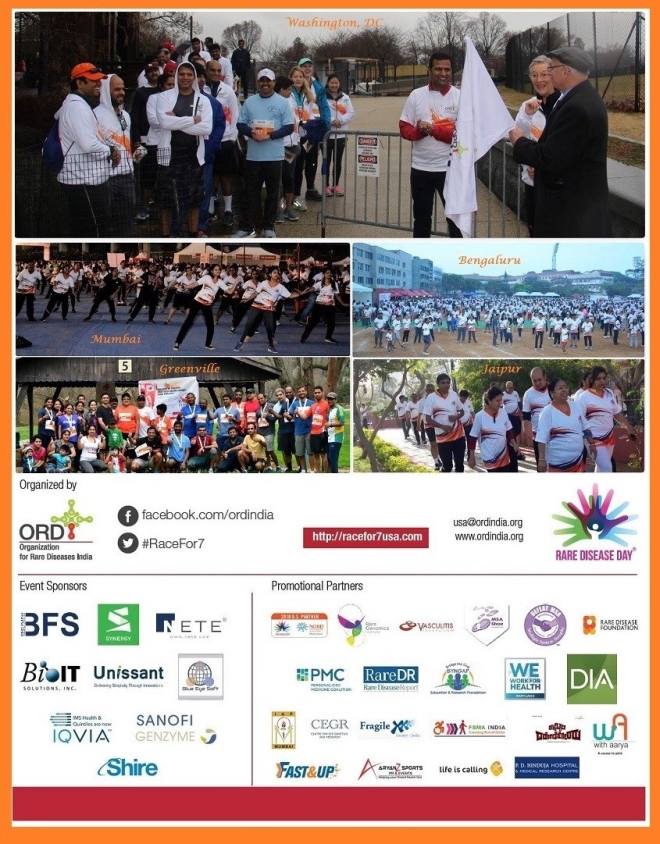
WASHINGTON, March 8, 2018 /PRNewswire/ — Rain did not dampen spirits for those racing against rare diseases. Racefor7 supporters in Washington, D.C. were greeted with rainy skies on Feb. 25, 2018. The rare disease awareness walk/run met at the Sylvan Theater near the Washington Monument to participate in the 7,000 meter course. About 60 attendees joined almost 6,000 participants for rare disease awareness globally; in Bengaluru, Jaipur, and Mumbai, India and Greenville, S.C.
Co-founder of the Organization for Rare Diseases India (ORDI) and Racefor7, Harsha Rajasimha, M.S., Ph.D., stated that the hope was “to extend the event as a global chain,” linking the U.S. and India in their fight against rare diseases. Rajasimha is also co-director of the Rare Diseases Systems Biology Initiative at George Mason University, Fairfax, VA. ORDI co-founders Prasanna Shirol and Sangeeta Barde supported the international expansion of Racefor7 from India.
“More than 350 million people worldwide suffer from rare diseases and their chronic comorbid conditions. We are honoring their indomitable spirit and will to fight towards getting treatment and dealing with their conditions day-to-day,” he said at the event.
To highlight the 7,000+ known rare diseases, names of individual diseases were printed on the race bibs received by participants.
Chief guests William A. Gahl, M.D., Ph.D., Clinical Director, National Human Genome Research Institute (NHGRI) and Cynthia Tifft, M.D., Ph.D., Deputy Clinical Director, NHGRI, as well as members of the rare disease community talked about their specific disease.
Gahl and Tifft, in their speeches, noted that diagnosis is important, not only to give a name to the disease and provide treatment, but to give access to health care, physical therapy and community support to patients and their families who may have been trying to handle physical and emotional burdens on their own. Tifft added that with diagnosis, “mothers and fathers can stop feeling guilty that they were the ones that caused (their child’s illness). These are genetic diseases. I’ve told thousands of parents, none of us has any control over which genes we pass on to our children. Once you have a diagnosis, you can live with the diagnosis and get better.”
It ends a “diagnostic odyssey,” Tifft said, reminding the audience that diagnosis for many rare disease patients takes an average of seven years.
Patients, including Benita Talati and Sara Stachkunas spoke about their own struggles with their diseases. Talati herself spoke of Ehlers-Danlos Syndrome. The genetic disease has a number of associated comorbid conditions including extreme myopia, hernias, dental overcrowding, scoliosis, digestive issues and women’s health issues. With 13 types of EDS and a host of other comorbid conditions, patients with EDS experience much longer diagnostic odyssey. Talati said, “My EDS is of the hypermobile variety and took 35 years to diagnose. Thankfully, it’s not the vascular type because most patients (with the type) die in their 40s.”
Sara Stachkunas, a teenager from VA with Congenital Adrenal Hyperplasia (CAH) and her guardian Deborah Stachkunas spoke about working to improve access to Solu-Cortef® and trained medical technicians to provide the life-saving medication in a crisis, both in schools and in ambulances. A patient with CAH may have an adrenal crisis from a fever, flu or car accident, Stachkunas noted. “When you need the injection, you do not have the mental or physical capacity to inject yourself,” she said.
Click here to read more.



